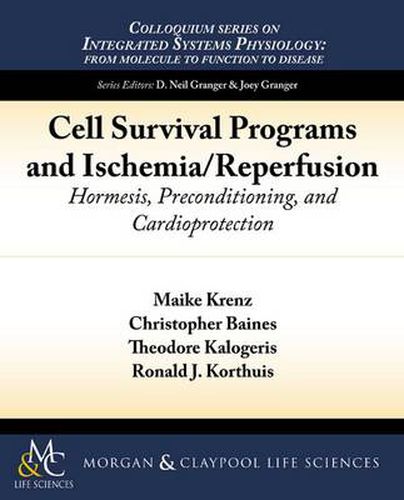Readings Newsletter
Become a Readings Member to make your shopping experience even easier.
Sign in or sign up for free!
You’re not far away from qualifying for FREE standard shipping within Australia
You’ve qualified for FREE standard shipping within Australia
The cart is loading…






The major purpose of this book is to review the evidence supporting the concept that intrinsic cell survival programs can be activated by a variety of mildly noxious stimuli or pharmacologic agents to confer protection against the deleterious effects of ischemia/reperfusion (I/R). We begin with a discussion of the concept of hormesis (a term used most extensively in the toxicologic literature which refers to biphasic cellular responses that depend on concentration or intensity of a stimulus), review the seminal studies that led to the discovery of the cardioprotective effects of ischemic preconditioning, and outline its therapeutic potential (Chapter 1). This is followed by a summary of our current understanding of the mechanisms of I/R injury (Chapter 2), as this provides several points of intervention in limiting postischemic tissue injury that may be targeted by the adaptive programs invoked by conditioning stimuli. Chapters 3 and 4 focus on the mechanisms underlying ischemic pre-, post-, and remote conditioning, which establishes the mechanistic rationale for development of pharmacologic conditioning strategies that may mimic the remarkably powerful effects of ischemic conditioning (and are covered in Chapter 5). Lifestyle interventions, including exercise, caloric restriction, and consumption of alcoholic beverages and/or phytochemicals, that may induce hormetic responses will also be reviewed in this chapter. While the promise for conditioning as a therapeutic approach is enormous, there are obstacles to its practical application in patients, which are covered in Chapter 6. The final chapter (Chapter 7) examines the extension of our mechanistic understanding of the signaling pathways invoked by conditioning stimuli into the realm of gene therapy and to the preservation of stem cell viability in the harsh ischemic environment as natural translational outgrowths of preconditioning into therapeutics.Table of Contents: Introduction / Hormesis and Preconditioning Defined / Mechanisms of Ischemia/Reperfusion Injury / Ischemic Preconditioning and Cardioprotection / Clinically Useful Applications of Ischemic Conditioning: Distant Site Ischemic Preconditioning and Ischemic Postconditioning / Cardioprotection Induced by Pharmacologic Conditioning and Lifestyle Interventions that Mimic Preconditioning / Cardiovascular Risk Factors, Tachyphylaxis, and the Efficacy of Pre- and Postconditioning / Logical Extensions of Preconditioning: Gene and Stem Cell Therapy for I/R / Acknowledgments / References
$9.00 standard shipping within Australia
FREE standard shipping within Australia for orders over $100.00
Express & International shipping calculated at checkout
Stock availability can be subject to change without notice. We recommend calling the shop or contacting our online team to check availability of low stock items. Please see our Shopping Online page for more details.
The major purpose of this book is to review the evidence supporting the concept that intrinsic cell survival programs can be activated by a variety of mildly noxious stimuli or pharmacologic agents to confer protection against the deleterious effects of ischemia/reperfusion (I/R). We begin with a discussion of the concept of hormesis (a term used most extensively in the toxicologic literature which refers to biphasic cellular responses that depend on concentration or intensity of a stimulus), review the seminal studies that led to the discovery of the cardioprotective effects of ischemic preconditioning, and outline its therapeutic potential (Chapter 1). This is followed by a summary of our current understanding of the mechanisms of I/R injury (Chapter 2), as this provides several points of intervention in limiting postischemic tissue injury that may be targeted by the adaptive programs invoked by conditioning stimuli. Chapters 3 and 4 focus on the mechanisms underlying ischemic pre-, post-, and remote conditioning, which establishes the mechanistic rationale for development of pharmacologic conditioning strategies that may mimic the remarkably powerful effects of ischemic conditioning (and are covered in Chapter 5). Lifestyle interventions, including exercise, caloric restriction, and consumption of alcoholic beverages and/or phytochemicals, that may induce hormetic responses will also be reviewed in this chapter. While the promise for conditioning as a therapeutic approach is enormous, there are obstacles to its practical application in patients, which are covered in Chapter 6. The final chapter (Chapter 7) examines the extension of our mechanistic understanding of the signaling pathways invoked by conditioning stimuli into the realm of gene therapy and to the preservation of stem cell viability in the harsh ischemic environment as natural translational outgrowths of preconditioning into therapeutics.Table of Contents: Introduction / Hormesis and Preconditioning Defined / Mechanisms of Ischemia/Reperfusion Injury / Ischemic Preconditioning and Cardioprotection / Clinically Useful Applications of Ischemic Conditioning: Distant Site Ischemic Preconditioning and Ischemic Postconditioning / Cardioprotection Induced by Pharmacologic Conditioning and Lifestyle Interventions that Mimic Preconditioning / Cardiovascular Risk Factors, Tachyphylaxis, and the Efficacy of Pre- and Postconditioning / Logical Extensions of Preconditioning: Gene and Stem Cell Therapy for I/R / Acknowledgments / References